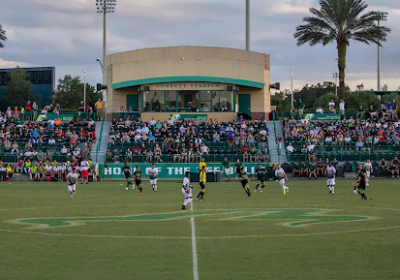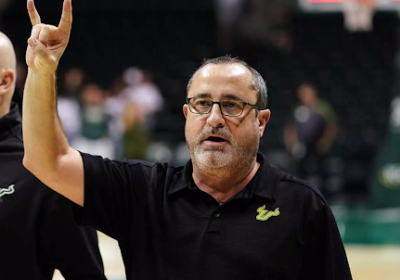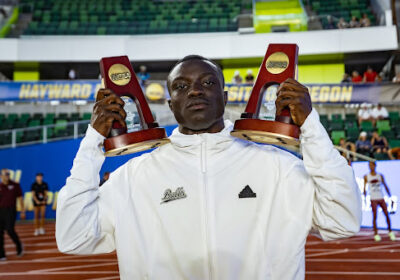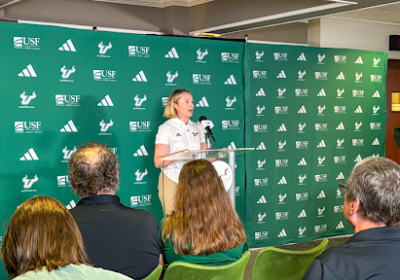Concussions blur the line between acclaim and anguish

ORACLE FILE PHOTO/ADAM MATHIEU
From the blindside sack to the explosive hit that jars the ball loose, fans and players alike enjoy little more than a crushing blow delivered on the field of play.
Athletes across the world have made their names by playing sports with a brutal intensity that gives fans the occasional jaw-dropping moments that fill both top-10 highlight reels and hospital rooms.
But while these dramatic collisions have elevated sports — primarily football — to new heights, evolving science is revealing the associated risks may not be worth the sought after rewards.
Despite how little is known about brain injuries such as Chronic Traumatic Encephalopathy (CTE), it’s been well documented in recent years that the effects of this disease can be life-threatening.
Junior Seau, Jovan Belcher, Dave Mirra, and countless other athletes have not only been affected by CTE, but have taken their lives because of it.
In addition to bouts of depression and rage, CTE can have a litany of effects on the brain including memory loss, problems with attention span, and a loss of balance and motor functions.
Dr. Martin Muschol, a USF professor and researcher of physics, has found through experimentation that brain diseases such as CTE could begin when proteins in the brain start to self-replicate following traumatic impact to the head.
Muschol, who was given a three-year, $440,000 grant renewal from the National Institutes of Health to continue work on the causes of brain diseases such as CTE and Alzheimer’s, found that in his experiment, the protein formed from trauma was able to self-replicate in the presence of a natural environment similar to that of the human brain.
“Our striking observation was that we could actually separate this aggregation process into two stages,” Muschol said. “We first used harsh conditions to generate a seed. Once we had those seed aggregates, we could harvest them out of the solution and throw them back under new physiological conditions in the presence of the native protein. And surprisingly enough, they continued to grow from the native protein.”
While Muschol stressed that his research may not be the exact conditions that occur in the human brain, this protein seed formation and eventual development may provide insight to the formation of brain disease.
“That’s what gave us this idea that there might be a relationship to something like CTE where you have a singular event that induces the initial seed formation, but once these seeds have formed, you can take away these non-physiological conditions that exist perhaps in CTE during repeated head trauma,” Muschol said.
“The head trauma goes away and the patient seems to be back to normal, but many years or sometimes decades down the road, all of a sudden this phenomena occurs because this aggregation process that we have now separated shows fast seed formation and slow replication. That’s our idea, that there’s a two-step process potentially relevant to problems with CTE where you have impacts early on and then a long latency face before the problems appear.”
For athletes, like former USF defensive lineman Todd Chandler, the years he spent taking his fair share of hits on the field have already started to take their toll.
“I’ve done research on things I’m dealing with,” Chandler said. “Sometimes out of nowhere, I’ll have severe migraines and anger problems. When I saw (“Concussion”), that’s what made me do a lot more research on my own about the anger problems I’m dealing with.
“When I was in high school, I noticed off and on out of the blue I would get a bad headache and I just thought it was life and that happens; but as I went on in college, I started noticing it more and more.”
Chandler said he had four concussions during his collegiate career, with the worst of them coming in his final game for the Bulls.
As the clock ticked down in the final minutes of USF’s season finale against UCF in 2014, Chandler sat on the sidelines, recovering from a concussion earlier in the game in which he briefly lost consciousness.
The former Bull hasn’t played football since that final game, but he said there are times he couldn’t tell by how his body feels.
“It’s been two years since I’ve put on pads, and I still wake up sore like I just played yesterday,” Chandler said. “There’s a lot of stuff that nobody tells you about football, but it comes with it. I don’t complain about it, I don’t tell my fiancee I’m hurting. It just comes along with it because it’s a part of football.”
Current USF players and coaches were not made available for this story and the school declined to comment on the issue.
For other athletes such as former USF safety Jamie Byrd, the consequences from developing CTE are frightening, but something that must be accepted when a player puts the pads on.
“That was scary when Junior Seau died,” Byrd said. “I would rather not hear about those things happening, but once you do hear about it, it does scare you a bit. It kind of backs you off, it makes you think, ‘I wonder if that could happen to me, because they didn’t plan on it happening to them.’
“You have to have your tackling technique down, but when you get blindsided some of those things just come with the game. When you sign up for football, you have to know what you’re signing up for.”
A large part of what makes CTE so difficult to study is that the affected brains can only be studied post-mortem. This helps researchers understand the effects of the disease, but lends little insight into the development of the disease and how it can be combated.
As has been the prevailing thought in science about CTE, Muschol’s research points toward repeated head trauma, especially in football players and boxers, as the most likely cause of this disease.
However, the formation of CTE is still being tested and experimented with.
Muschol’s research may point to how brain diseases born from trauma develop, as he links CTE and Alzheimer’s with the aging process of the human body.
The human body has cells made to regulate the protein buildup caused from trauma, but as the body ages, it loses the ability to remove the unwanted protein and eventually brain disease, such as CTE or Alzheimer’s, takes hold.
“The assumption is that it’s a lack of this machinery to identify and seek out these proteins,” Muschol said. “You constantly generate new proteins. When you generate them, they’re typically not properly folded yet. Your machinery is there to seek out the ones that aren’t properly folded and either help them fold properly or dissociate them.
“There are pretty scary studies, for example, in the case of Alzheimer’s that your probability of developing Alzheimer’s basically goes up with age, progressively. So it’s not a question of if you will develop Alzheimer’s, it’s when. So that means at some point, your cellular machinery that protects you from this becomes weak enough to succumb to this onslaught of protein that are forming.”
From targeting rules in football to new helmet designs, efforts are being made to protect athletes from brain disease, but players such as Byrd don’t see a way to guarantee player safety without dramatically changing the sport.
“How I feel is that you can’t really prevent it,” Byrd said. “I don’t want to seem like I don’t care about it because I do because people are getting injured from stuff like that, but it’s so hard to prevent.
“If you want to really prevent it, you’re going to have to put big helmets with so much padding it’s going to make players’ games decline.”
But as research continues to uncover new information that could help people better understand brain diseases such as CTE, the question that must be asked is if the risk is worth the reward?
“I think as a society, we have to ask if we really want to expose athletes to these risks,” Muschol said. “It seems a little bit like gladiator games in a way. As a society we have to ask ourselves as much as everyone likes sports and entertainment — and I’m a big soccer fan — but if you know these people expose themselves to these high risks of getting these devastating diseases, you have to look at that as well and ask yourself if this is really the society we want to have.
“It’s already happening that parents are seriously thinking about it, do we really want to have our kids participate in these sports particularly if there is a risk for concussions? And you know, you can’t blame them. We don’t know enough about it. What exactly is the threshold? How many concussions are too many? How prone are you? You may be more prone to these affects. At the end of the day I think parents have to ask these questions and come up with an answer they feel comfortable with.”








